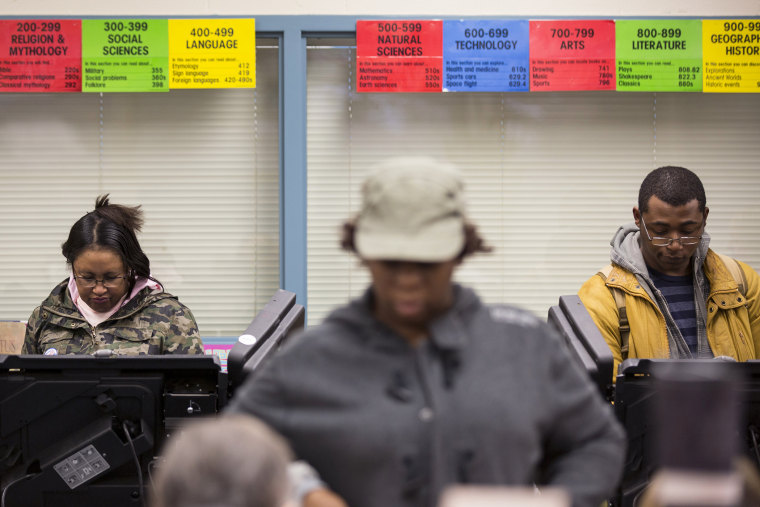New documents were filed Wednesday in a federal lawsuit aimed at making it easier for African-Americans to get elected in Ferguson, Missouri, after last year’s unrest brought attention to their severe under-representation in the city’s government.
Voting rights lawyers with the American Civil Liberties Union, representing a group of local black residents, urged a judge to rule in their favor in a Voting Rights Act challenge to the Ferguson-Florissant school district’s use of an at-large voting system. That system, they alleged in the original complaint filed in December, is helping to keep blacks “all but locked out of the political process.”
The school district filed its own papers Wednesday asking for a ruling in its favor, and calling the district "a vibrant, integrated and dynamic environment." A spokeswoman for the district declined to comment Thursday.
Although African-Americans make up 77% of students in the district, just one out of seven members of the school board were black when the case was filed last year. In April, one additional black member was elected. The plaintiffs' filing shows that over the last decade or so, very few black candidates have managed to get elected to the board, though many have run.
The lawsuit claims that the under-representation of minorities is the result of the at-large system, in which all candidates are elected by all the voters, rather than representing specific geographical areas. Such systems can make it hard for minority voters to elect their preferred representatives, because although they might be a majority in one district, they’re outnumbered across the entire jurisdiction. As such, they’ve historically often been used to dilute minority voting power. Several recent cases have made clear that the practice continues today.
RELATED: Ferguson Commission releases reform wish list
But in their own filing, lawyers for the school district note that African-Americans now make up a slight majority of the district's voting-age population, meaning an at-large system should work in blacks' favor, not against them.
The reason it doesn't is that white turnout is consistently higher than black turnout for school board elections. But the plaintiffs say this, too, is a result of discriminatory election rules, like holding the elections in April with no other contests on the ballot—an arrangement that consistently leads to lower turnout among more marginalized voters.
Central to the case against the school district is what civil rights advocates say are decades of systemic, political, economic, and housing discrimination on racial lines in the St. Louis region. Some of that history was detailed in a scathing Justice Department report released in March, which noted that until the 1960s, Ferguson was a “sundown town,” where blacks were banned from the city after dark. The report also found ongoing racial inequities in the city’s law enforcement system, and numerous examples of explicit racial bias among police department employees.
The school district itself was created by a 1975 desegregation order intended to remedy the effects of discrimination against African-American students.
“One of the reasons that Ferguson has received so much attention is because it sits within this long history of segregation and discrimination.”'
Julie Ebenstein, an ACLU lawyer, sought to put the school district lawsuit into this broader context of systemic racial bias.
“One of the reasons that Ferguson has received so much attention is because it sits within this long history of segregation and discrimination,” Ebenstein said. “And beyond just the killing of Michael Brown and the protests, the awareness in the DOJ report and other things of how some of the discriminatory policies take hold and continue on has really been striking. So to me, this is part of that bigger picture.”
The lawsuit is part of a broader push to increase black political representation in Ferguson, where the shooting death last August of an unarmed black teen, Michael Brown, at the hands of a white Ferguson police officer sparked weeks of protest. The unrest drew attention to the fact that although two thirds of Ferguson residents are black, six out of seven city councilmembers, including the mayor, were white. In April, after an energetic push by local leaders to mobilize the minority community, two new black council-members were elected, bringing the total to three.
In November, a grand jury declined to indict Darren Wilson, the officer who shot Brown. Wilson told investigators he feared for his safety during a scuffle with Brown.
In Thursday’s filing, the lawyers for the plaintiffs argue that there’s no real dispute about several key facts that together are sufficient to prove a violation of the Voting Rights Act. Among them:
- That there are enough black residents of the district, and they live close enough to each other, that it would be possible to create seven single-member districts, four of which would have a black majority.
- That under the current system, candidates preferred by black voters usually lose, and those preferred by white voters usually win.
- That election campaigns for the board have often involved subtle racial appeals to white voters.
- That the board is not responsive to the concerns of African-Americans in the district.
- That the region has a long history of official discrimination that continues to harm African-Americans.
Black students appear to be faring poorly under the current school board. Though they make up 77% of the district’s students, they were just 35% of those enrolled in the district’s Gifted and Talented program, according to Department of Education figures. Blacks made up nearly nine out of 10 non-disabled kids placed in in-school suspension. And of the 51 students who were subject to a school-related arrest in 2011, every one was black.
